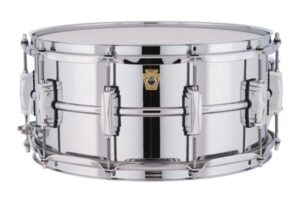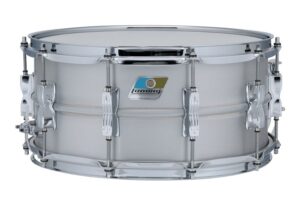Crafting music that leaves its footprints on the listener’s consciousness requires the right instruments, and drums play a crucial role in setting the rhythm and boosting the experience.
The 1960s have a profound impact on music. The era witnessed many talented musicians that impacted young drummers.
One thing that connects almost every recorded music during the decade is the use of Ludwig snares.
Looking back in history, the use of Supraphonic was most common among all the drums.
Contrary to this, Acrolite is often mentioned as their early experience by drummers. However, the choice between both depends on many factors.
In this article, we will dive into a detailed comparison between two popular drum models: the Acrolite and Supraphonic.
By exploring their features like sound quality, versatility, pricing, durability, and user reviews of these drums, we will try to provide you with valuable insights that will help you choose the best one accordingly to your requirements and preferences.
Acrolite vs. Supraphonic – Comparison
Though Ludwig designed both drums, various key differences became apparent on comparing.
The Acrolite, once a staple in school bands, has evolved into a versatile drum with a distinct aluminum construction.
While Supraponic has successfully maintained its popularity as the most recorded snare drum in history.
Below is a detailed comparison that will shed light on their individual strengths.
A Brief Introduction to Acrolite and Supraphonic
Christopher Allis, an exceptional drummer from Los Angles with skills in live work, studio sessions, and remote drum tracking, highly endorses both Ludwig snares as compared to other drums for their quality sound and efficacy.
Acrolite
Introduced in 1960, the Acrolite gained popularity among drummers due to its classic design and exceptional sound. The drum features a 1.6mm thick shell.
This contributes to its balanced combination of warmth and projection, ultimately offering unique sonic properties.
Usually, Acrolite comes in a standard 14-inch diameter with different depths, allowing drummers to choose accordingly to their preferences.
Supraphoninc
This, too, introduced in 1960, soon became synonymous with professional-grade drumming due to its exceptional craftsmanship and sound quality.
An aluminum shell with a 1.2 mm shell thickness ensures consistent tone and durability. It, too, comes with a 14-inch diameter with a variety of depths.
Advantages and Unique Characteristics
One standout advantage of Acrolite is its versatility. It excels in various musical genres, ranging from rock and pop to jazz and funk.
Its aluminium shell provides a balanced tone, with a warm and focused sound. The Acrolite drum is highly responsive, offering drummers excellent sensitivity and dynamic range.
The Supraphonic drum stands out for its exceptional sound quality and tonal range.
Its excellent projection and sound cutting make it more favorable for drummers seeking assertive snare presence.
Its aluminium shell exhibits superior craftsmanship and attention to detail, eventually boosting its overall playing experience.
Construction and Tone
The construction and material of any drum are crucial for quality sound production and performance.
Any distinctions in these factors can lead to nuanced differences in sound and performance.
Acrolite comes with 8 lugs single flanged loop, while the Supraphonic has 10 lugs and a triple-flanged hoop. Additionally, both are equipped with a P-85 snare strainer.
The thickness of the shell enhances the drum’s sustain and allows for better resonance.
In the case of Acrolite, its 1.6mm thick aluminum shell ensures a consistent and even tone throughout the drum.
While Supraphonic’s 1.2mm thin shell resonates better and provides subtle variations in sound and response.
Additionally, the thin shell of the Supraphonic offers more focus and articulation of sound.
Sound Quality

Acrolite and Supraphonic are renowned for their exceptional sound quality and versatile tonal characteristics.
However, for Acrolite, it offers warm and rounded sound with a balanced mix of low-end depth and mid-range punch.
Their aluminium shells add to the natural brightness, boosting the drum’s overall tone.
Furthermore, the drum’s sensitivity and responsiveness enable drummers to achieve a broad dynamic range, from soft and subtle ghost notes to powerful rimshots.
Contrary to this, Supraphonic offers a more cutting sound with excellent projection and articulation.
Its aluminium shell, although slightly thinner, contributes to a crisper and more pronounced snare presence. This makes it more favorable for genres like rock, metal, and funk.
Versatility and Musical Styles
A drum’s sensitivity, tonal characteristics, and dynamic range make it versatile to complement different musical arrangements and techniques.
In Jazz, intricate brushwork and delicate cymbal work are crucial.
Acrolite, with its rounded sound and sensitivity, produces a smooth and articulate response, making it perfect for the genre.
Furthermore, in R&B, Acrolite’s responsiveness and dynamic range allow for expressive grooves and sharp snare attacks.
While talking about Supraphoninc versatility and musical styles it has brighter and more cutting-edge sounds.
This makes it suitable for genres where a pronounced and assertive snare presence is desired.
Price and Affordability
While opting for a drum, drummers must evaluate price and affordability.
Considering the construction, sound quality, and versatility, Acrolite offers good value for money.
These instruments are well-crafted and reliable, affordable for almost any drummer.
Their consistent performance and durability make them a worthy investment for all beginner and experienced players.
However, for Supraphonic, the case is slightly different. Professionals and highly experienced players mostly use these drums.
This uplifts their material and construction costs, eventually putting it out of the range of drummers with limited budgets.
While the Supraphonic may have a higher price, their unique advantages and tonal qualities make the additional investment worthy.
Furthermore, while choosing any drum, it is recommended to consider each drum model’s specific features and benefits to assess their value for money.
Durability and Build Quality

Talking about durability, both Acrolite and Supraphonic exhibit exceptional craftsmanship and construction.
Their aluminium shell ensures lightweight, seamless construction and boosts overall durability.
Acrolite drums’ hardware components, like lugs, hoops, and snare strainers, are specifically designed to withstand functionality over time.
Additionally, their thick shell, available in 5X14 and 6.5X14 sizes with a black galaxy finish, further ensures their durability for rough use.
Contrary to Acrolite, the Supraphonic have a thin shell and involves a sophisticated construction. Thus demands professional use and more care over time.
User Review and Feedback
User reviews of any product can provide a live explanation of its durability and quality.
The Acrolite, previously only used by beginners, is now welcomed on stages and in studios as well.
Talking about user reviews, many drummers report that Acrolite’s slightly muted yet crisp tone makes it perfect for live performances and soft tracks.
However, unlike the Supraphonic 10 lugs, the Acrolite has 8 lugs which makes it over-tighten sometimes.
In the case of Supraphonic feedback, the drum has an exceptional reputation, including its sound and ease of use.
The drummer reports that it’s quite easy to tone and remains in tone for longer than other drums.
However, drummers have shown concerns about P-85, which often needs replacement with P-86. Additionally, the drum wires also need sooner replacement.
The Bottom Line
The Acrolite and Supraphonic, both drums, provide an exceptional musical experience when played.
The Acrolite drum stands out for its versatile sound, durability, and affordability. This makes it an appealing option for drummers across multiple musical genres.
On the other hand, the Supraphonic drum holds a more professional reputation. It offers a brighter, more cutting sound, favoring it in rock, metal, and funk genres.
Ultimately, the decision between the Acrolite and Supraphonic drums depends on individual preferences, budget, and musical aspirations.
When choosing, drummers should consider factors such as sound quality, versatility, price, durability, and user reviews.






